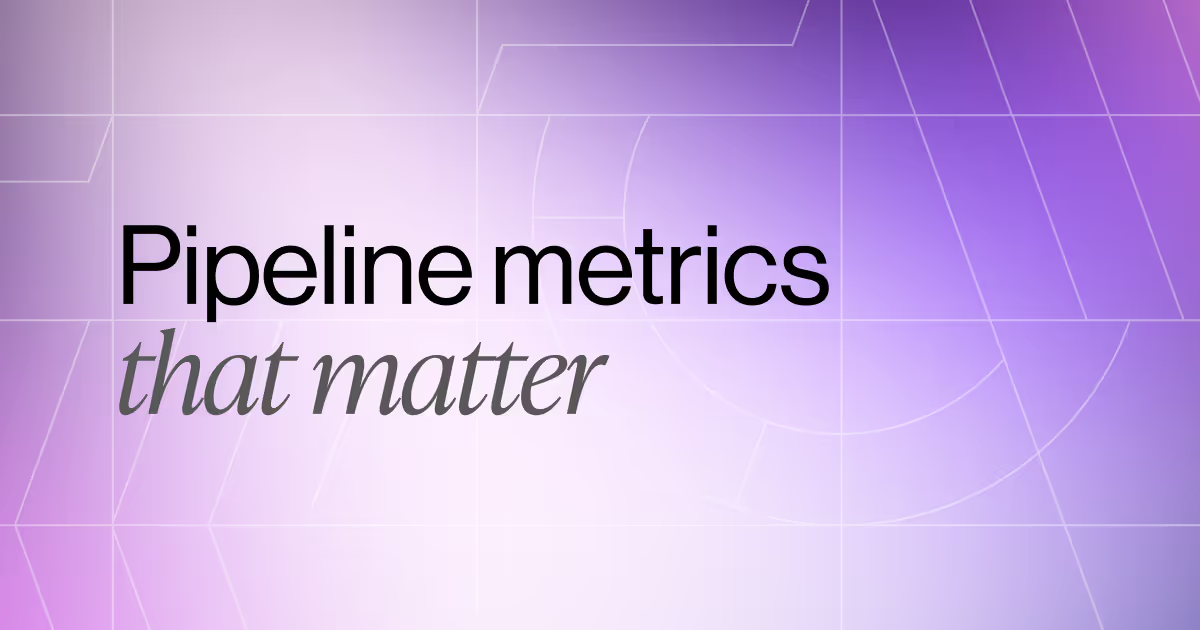What Is Sales Efficiency? (+7 Strategies to Improve It)
There are multiple ways to measure your sales team’s performance. Each metric emphasizes certain priorities while downplaying others. KPIs like new leads and pipeline value emphasize potential revenue, while conversion rate and average deal size let you see how much your team is bringing in. What sales metrics don’t tell you is the effort and resources that go into finding that potential and winning the close.
Enter sales efficiency: the metric that gives you a holistic view of your sales operations. Your sales efficiency isn’t just about the numbers your team is bringing in or how quickly they’re doing it. It’s a must-know metric that helps sales leaders understand whether your process (and company) are on a sustainable path.
What is Sales Efficiency, and Why Does it Matter?
Sales efficiency is the ROI of your sales efforts. This metric measures the new revenue your sales team generates against the resources it spends.
The amount of revenue your sales team brings in matters — it’s often the focus of conversations about sales goals and quotas. But high revenue numbers offset by equally high costs are a problem. Your sales efficiency speaks to your company’s overall profitability: a high sales efficiency ratio indicates good financial health.
Sales Efficiency vs. Sales Productivity
Sales productivity and sales efficiency often get used interchangeably, but they’re not the same thing:
- Sales productivity measures how much a rep or team produces in a given time period. It’s about activity volume: calls made, emails sent, demos booked, deals closed.
- Sales efficiency, on the other hand, focuses on output relative to input. It’s not just how much a rep is doing, but how effectively they’re converting effort into revenue.
If productivity is how many doors you knock on in a day, efficiency is how many of those doors actually open. A rep might be highly productive, making 100 calls a day. But if those calls aren’t converting into meaningful revenue, their efficiency is low. The goal is to strike the balance: productive reps doing the right things, in the most efficient way possible.
What High Sales Efficiency Looks Like
Though each company has its own sales secrets, efficient sales processes all share a few elements. Here’s how to check whether your sales practices measure up.
Maximized Revenue With Fewer Resources
Sales efficiency compares your sales revenue to resources spent, so highly efficient teams bring in a lot of money on a relatively low budget. This is a high-level concept that covers every step of the sales process, so it’s often harder for teams to measure.
We’ll talk more about how to improve a low sales efficiency ratio later — but to make sense of this principle as it applies to your team, investigate to see where your resources are spent. Not just your sales budget (though that matters, too!), but also your reps’ time and energy. Reviewing your budget is typically the easier practice, as most companies have accounting software. Learning how your reps are spending their time (and whether they feel they’re being efficient) will require conversations.
Once you have a full picture of your expenses and resource commitments, it will be easier to spot line items or tasks that take up a disproportionate amount of resources. Experiment to see if you can slim down your sales operations without negatively affecting your team’s key metrics.
Shorter Sales Cycles
The longer it takes to close deals, the more resources are spent. Teams with high sales efficiency know how to move leads through the pipeline quickly but without rushing them.
The length of your ideal sales cycle will depend on your product — but in general, more expensive products or services tend to have longer sales cycles. You can use internal metrics to build your own benchmarks. How long does it take your top reps to make a sale, and how different are your shortest and longest sales cycles on record? If all your reps are performing at a similar rate, your sales cycle may be where it needs to be. However, if there’s a big gap between your quickest and slowest sales, your team can improve.
High Rep Productivity and Motivation
Efficiency starts with your team, but productivity and motivation can be a double-edged sword. Reps who are ready and eager to put in the work can either boost your sales efficiency by focusing on the right areas or tank it by focusing on busy work or adding steps that slow down the sales process.
If your team is already motivated and productive, make sure the work they’re doing maps to important sales KPIs. An unmotivated team is a harder problem to solve — and it may signal a need to increase sales efficiency. Employees of all types perform best when they feel like the tasks they’re doing matter. Engage your reps in your efforts, and you’re likely to see their enthusiasm (and total sales) increase as well.
Focus on Scalability and Growth
Sales equals growth for most companies, but that doesn’t mean you can take success for granted. An efficient sales process is backed by sales planning. It’s structured and replicable, so reps aren’t reinventing the wheel every time they contact a new lead. And it’s profitable: Your team’s earnings exceed its budget.
If your process doesn’t meet these requirements, it’s time to start building a better one. A strategic and replicable sales flow will help your team work more efficiently.
How to Calculate Sales Efficiency
There are two approaches you can use to measure sales efficiency. The equations for both gross sales efficiency and net sales efficiency are simple; the bigger challenge is figuring out sales-related expenses. Your sales budget won’t tell the whole story. Salaries, employee benefits, software subscriptions, rep training, and other overhead should all be factored into your costs.
The period you use to calculate your sales efficiency will depend on your sales cycle. Many companies run the numbers by quarter, but those with faster sales cycles may want to know the monthly numbers instead.
Once you have a rough number for your expenses, use one of the following equations to calculate your sales efficiency.
Gross Sales Efficiency
Your gross sales efficiency measures sales and marketing spend against the new annual recurring revenue (ARR) your team brings in. Your gross ARR should include all new contracts, plus any increased revenue that came from customer upsells.
Gross sales efficiency = Gross new ARR / Sales and marketing costs
Your gross sales efficiency helps you see how your team is performing independent of other factors, like churn. Sometimes, the company suffers big losses that have nothing to do with sales, and measuring your team against them would misrepresent its work.
Net Sales Efficiency
Your net sales efficiency looks at the ARR your company lost as well as the ARR it gained. Find your net ARR by subtracting your churned ARR from your gross ARR. Then, you’re ready to calculate your net sales efficiency.
Net sales efficiency = Net new ARR / Sales and marketing costs
Your net sales efficiency is almost guaranteed to be lower than your gross sales efficiency, but it’s still important to know. First, because low retention rates may signal that your process is converting the wrong people. Second, because sales efficiency is meant to determine your ROI, you need an accurate view of your returns — and that means accounting for contracts that didn’t pan out.
What’s a Good Sales Efficiency Ratio?
The higher your sales efficiency ratio, the better. Your company will fall into one of four bands:
- Sales efficiency ratio below 1: A ratio below 1 means you’re spending more on sales than your company is earning. Sales teams in this boat need an overhaul, and fast.
- Sales efficiency ratio around 1: This is the break-even point, and it’s not great news. Companies have expenses that aren’t related to sales, so if your sales efficiency is only at 1, you’re likely losing money overall. Take steps to increase your sales efficiency now.
- Sales efficiency ratio between 1 and 3: Most companies fall into this category, and it’s a pretty good place to be. Your sales team is bringing in enough money that the company is profitable. However, it’s still worth evaluating your process for inefficiencies.
- Sales efficiency ratio over 3: This is the realm of rockstars, but it’s also a potential sign that you’re not spending enough on sales. Talk to your team to see if they have unmet needs — you may end up increasing your revenue.
It’s natural for your sales efficiency ratio to fluctuate from quarter to quarter. The best way to get a good baseline is to calculate your ratio for this and previous quarters. Then, you can watch how changes to your sales process affect your numbers.
7 Strategies to Improve Sales Efficiency
Ready to start improving your sales efficiency ratio? We’ve pinpointed seven steps you can get started on right now to make your team more efficient.
1. Automate Admin Tasks
Nothing chips away at efficiency like busywork. When reps are stuck updating CRMs, scheduling follow-ups, or manually tracking commissions, they’re not selling—they’re surviving the work around selling. Automation solves that. With the right systems in place, sales teams can eliminate the drag of manual work and reclaim hours each week.
Identify which non-selling activities are eating up the most hours for your team: shadow reps, audit calendars, or run a time-tracking exercise for a week. Once you know where the drag is, automation can step in. Email sequences can handle outreach and follow-ups, while CRM workflows can log activities and move deals through stages automatically.
2. Prioritize High-Intent Leads
If your reps spend time chasing prospects who aren't ready to buy, efficiency tanks. You get bloated pipelines, longer sales cycles, and frustrated teams wondering why no one’s picking up the phone.
Prioritizing high-intent leads ensures reps are spending their time where it counts. Partner closely with marketing and RevOps to build or refine a lead scoring model that surfaces the signals that actually correlate with conversion (e.g visiting pricing pages, attending webinars, replying to outreach). Map out your ICP so reps can quickly qualify or disqualify leads, and make sure those high-intent leads are routed fast.
Efficiency is about doing more of the right things. When your team zeros in on the buyers who are already raising their hands, everything moves faster—deals close quicker, conversion rates rise, and win rates climb.
3. Optimize Your Sales Compensation Plan
Fair compensation supports sales efficiency by boosting team morale and keeping turnover rates low. Most sales reps receive some form of incentive-based compensation. Whether yours receive extra perks and benefits, equity, or a commission, these rewards can be a big motivator…or a big letdown.
An effective sales compensation plan boosts morale while aligning your sellers’ actions with your company’s sales plan. Look at whether your reps’ efforts are reflecting your expectations. If they’re prioritizing big, chancy contracts while ignoring the lower-level relationships that provide a steady income for your company, it may be time to restructure your incentives.
While you’re at it, compare your sales compensation plan with other companies in your market. You don’t need the same structure or incentives, but if you’re not competitive, your team may have a high turnover. Having to replace sellers, train the newcomers, and have them rebuild relationships can put a serious dent in your sales efficiency.
4. Implement Sales Enablement Tools
Sales enablement tools boost your reps’ efforts by centralizing everything they need to find, engage, and nurture leads. They often come with a heavy dose of machine learning and automation and provide your team with valuable analytics.
CRMs are far from the only game in town. Look for tools that provide:
- Communications and engagement facilitation: Aside from software that simplifies and centralizes phone and email messaging efforts, look for platforms that help sellers quickly create pitches, proposals, and multimedia content. These tools help reps quickly personalize each communication to increase engagement rates.
- Sales intelligence: Tools that track and analyze how leads engage (or don’t) with communications can guide your reps toward more effective methods.
- Content management: Reps have to juggle multiple sales and marketing materials. Make it easy for them to find assets tailored to each lead’s needs, demographic, and position in the sales pipeline.
- Training materials: Help reps stay sharp and centralize your onboarding process with a library of resources sellers can access anytime.
- Integrations: Every item in your sales tech stack should talk to the others, so customer information, sales content, performance data, and other important details are automatically propagated across your systems.
The right sales enablement tools can also help you with the first and second steps in our list. This is one example of how spending more on your sales team can boost its efficiency.
5. Streamline the Sales Process
We already talked about the importance of a replicable process, but sellers shouldn't replicate unnecessary or redundant sales activities with each lead. Analyze how efficient your process is by identifying the various stages leads progress through and milestones your reps achieve in each.
Then, look at the process reps follow: Is every task geared toward moving a customer from stage to stage or getting them to a milestone? What would happen if your reps skipped over an action they’re used to taking?
Most teams have at least one or two steps that are holdovers from previous processes or that have become less necessary as the market and/or your sales tools evolved. If you’re not sure how essential any given step is, consult your sales analytics to see if it succeeds in moving leads further down the pipeline.
6. Improve Cross-Team Collaboration
Sales teams can’t achieve what they do on their own. Give them more chances to connect with individuals on other teams who can help them succeed. This requires buy-in from other departments, but everyone involved will benefit.
Sales reps should be on the same pages as:
- Marketing: Marketing teams engineer early touchpoints and deliver leads to the sales team. They also create content and assets that can help with the sales process. However, they rarely see how well their leads and assets perform. Encourage your reps to share feedback on these elements with marketing and set up meetings where team members can work together to refine their process.
- Customer Success: Just as marketing delivers leads to sales, sales reps pass on new customers to the customer success team. The handoff will leave a lasting impression. Encourage your sellers to ask customer success for their impression of how well the transition goes and if sales can provide any support. In return, the sales team may be able to help customer success win renewals and upsells (and combat churn).
- Product: Sales reps don’t have a job if there’s no product to sell, so they should make time to speak with the product team regularly. Both sides bring something to the table here: Sales can share front-line reports of customers’ biggest pain points and most desired features. Product can make sure sales understands how the product works, so they can answer more technical questions and avoid misinforming leads on essential points. Regular check-ins help keep both teams’ expectations aligned with each other and reality.
It may seem counterintuitive to improve sales efficiency by pulling your sellers away from their desks. However, taking the time to communicate internal needs and align with other teams can bring much larger returns than an extra half-hour on sales calls would.
7. Invest in Sales Training
Sales is a high-skill job, and the best reps are those who treat each new lead as a chance to outperform their previous best. Sales courses can help sellers learn new techniques and further develop essential skills.
Alongside general sales training, look into programs specific to the methodology your company uses and the industry you work in. These courses can help reps create frameworks to guide their communications and help them understand the mindset, needs, and concerns of the prospects they’ll be talking to.
Don’t let the training be a one-and-done thing: Take the lead on regular sales coaching sessions to reinforce what reps learned and help them reflect on their performance. The more you invest in your team, the more they’ll bring back to your company.
Kick Off a New Age of Efficiency With CaptivateIQ
Improving your sales efficiency is a long-term effort, but like all big problems, it’s best tackled in steps. The best place to start is wherever you think you can make a difference. Your reps will notice when process changes bring better results, and they’ll be more willing to join the next experiment.
CaptivateIQ doesn’t have a magic button that can make your team more efficient, but it does give sales managers like you the tools to design smarter incentive programs, model outcomes, and engage reps where it counts. In a world where every deal matters, that kind of efficiency is a competitive edge.
Get the best in data-driven sales performance tools. Book a demo with the CaptivateIQ team today.
Sales Efficiency Frequently Asked Questions (FAQs)
What is Efficiency in Sales?
Sales efficiency is a measure of how effectively your sales team turns resources—such as time, compensation, and tools—into revenue. It evaluates the return on investment (ROI) for your sales activities by comparing the new revenue generated to the total costs associated with acquiring it.
What is Good Sales Efficiency?
A good sales efficiency ratio typically falls between 1 and 3:
<1: You're spending more than you're earning—this is unsustainable.
~1: You’re breaking even, which still puts overall profitability at risk.
1–3: Healthy zone for most companies—sales is contributing positively to profitability.
>3: Indicates extremely efficient sales efforts, but may signal underinvestment in sales resources
How to Calculate Sales Efficiency Formula?
There are two primary formulas, gross and net sales efficiency:
Gross Sales Efficiency = Gross New ARR / Sales and Marketing Costs
Net Sales Efficiency = (Gross ARR – Churned ARR) / Sales and Marketing Costs
Gross shows pure acquisition efficiency, while net includes the impact of churn—giving a clearer picture of ROI.
.svg)








